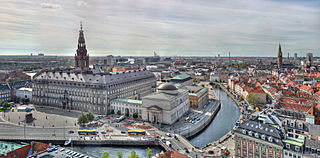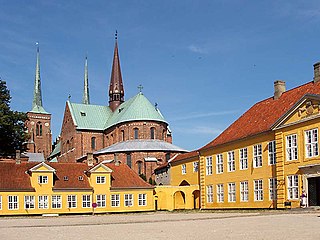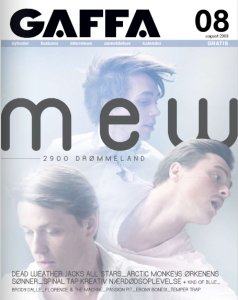Related Research Articles

Aarhus is the second-largest city in Denmark and the seat of Aarhus municipality. It is located on the eastern shore of Jutland in the Kattegat sea and approximately 187 kilometres (116 mi) northwest of Copenhagen.

Copenhagen is the capital and most populous city of Denmark. As of 1 January 2020, the city had a population of 794,128 with 632,340 in Copenhagen Municipality, 104,305 in Frederiksberg Municipality, 42,989 in Tårnby Municipality, and 14,494 in Dragør Municipality. It forms the core of the wider urban area of Copenhagen and the Copenhagen metropolitan area. Copenhagen is situated on the eastern coast of the island of Zealand; another portion of the city is located on Amager, and it is separated from Malmö, Sweden, by the strait of Øresund. The Øresund Bridge connects the two cities by rail and road.

Steen Eiler Rasmussen, Hon. FAIA was a Danish architect and urban planner who was a professor at the Royal Danish Academy of Fine Arts, and a prolific writer of books and poetry. He was made a Royal Designer for Industry by the British Royal Society of Arts in 1947.

Roskilde, located 30 km (19 mi) west of Copenhagen on the Danish island of Zealand, is the main city in the eponymous municipality. With a population of 51,262, the city is a business and educational centre for the region and the 10th largest city in Denmark. It is governed by the administrative council of Roskilde Municipality.
The International Council for the Exploration of the Sea is the world's oldest intergovernmental science organization. ICES is headquartered in Copenhagen, Denmark, where its multinational secretariat staff of 51 provide scientific, administrative and secretarial support to the ICES community. It was established on July 22, 1902, in Copenhagen.

The history of Copenhagen dates back to the first settlement at the site in the 11th century. From the middle of the 12th century it grew in importance after coming into the possession of Bishop Absalon, and the city was fortified with a stone wall during the 13th century. The harbour and the excellent possibilities for herring fishing contributed to Copenhagen's growth and development into an important trading centre. It was repeatedly attacked by the Hanseatic League as the Germans became aware of its expansion. In 1254, it received its charter as a city under Bishop Jakob Erlandsen.

Copenhagen Municipality, also known in English as the Municipality of Copenhagen, located in the Capital Region of Denmark, is the largest of the four municipalities that constitute the City of Copenhagen, the other three being Dragør, Frederiksberg, and Tårnby. The Municipality of Copenhagen constitutes the historical city center and the majority of its landmarks. It is the most populous in the country with a population of 637,936 inhabitants, and covers 86.4 square kilometres (33.4 sq mi) in area,. Copenhagen Municipality is located at the Zealand and Amager islands and totally surrounds Frederiksberg Municipality on all sides. The strait of Øresund lies to the east. The city of Copenhagen has grown far beyond the municipal boundaries from 1901, when Frederiksberg Municipality was made an enclave within Copenhagen Municipality.
The Copenhagen Institute for Futures Studies is a Danish not-for-profit, independent futures think tank founded in 1969 by Thorkil Kristensen, former OECD Secretary-General for the betterment of our society. The Institute's mission is to facilitate knowledge about potential futures and it hosts various events during the year and collaborate on others, in Denmark and abroad. Lastly the Institute produce several publications, such as reports, magazines and books.

East Jutland metropolitan area is a potential metropolitan area in Jutland and Funen, Denmark. Aarhus is the most populated city in the region.

The Danish Film Institute is the national Danish agency responsible for supporting and encouraging film and cinema culture, and for conserving these in the national interest.

Vordingborg is an old ferry town in Vordingborg Municipality in Denmark with around 18,000 inhabitants. Because of three large estates surrounding the town, a coherent urban development has not been possible, which is the reason why three satellite towns have emerged around the town. Within the ring of estates, the town has 12,000 inhabitants, and 18,043 inhabitants when including the three satellite towns of Ørslev, Nyråd and Stensved, situated 1, 3 and 5 kilometres, respectively, from the town of Vordingborg. Vordingborg Municipality (Kommune) has a population of 46,000.

Hvidovre is the main town in Hvidovre Municipality, Denmark. The town, a suburb of Copenhagen, is about 10 km southwest of the capital's center. It is the 2nd biggest suburb of Copenhagen, only beaten by Frederiksberg. It is also one of the biggest cities in all of Denmark.

Esbjerg is a seaport town and seat of Esbjerg Municipality on the west coast of the Jutland peninsula in southwest Denmark. By road, it is 71 kilometres (44 mi) west of Kolding and 164 kilometres (102 mi) southwest of Aarhus. With an urban population of 72,037 it is the fifth-largest city in Denmark, and the largest in West Jutland.

Gaffa is a free nordic music magazine with local editions in Denmark, Norway, and Sweden. Gaffa is Denmark's largest and oldest music magazine. It has been published since 1983 and has 320,000 print readers and 750,000 online readers each month.

Fotografisk Center is an exhibition space in Copenhagen, Denmark, dedicated to international and Danish photographic art. Since 1 January 2016 it has been based in the Copenhagen Meat Packing District at Staldgade 16, 1799 Copenhagen V.
Danes Worldwide, originally known as Dansk Samvirke, is an organisation which represents Danes who live abroad for personal or career reasons. Its activities include educational programmes, local networking around the world, and participation in the public debate on matters relevant its members. The association was also involved in the establishment of the Fredensborg Houses north of Copenhagen which offer lucrative housing to Danes who return home after long periods abroad.
The following is a timeline of the history of the city of Copenhagen, Denmark.

Henrik Bjørn Valeur is a Danish architect-urbanist, founder and creative director of UiD (Denmark) and UiD Shanghai Co., Ltd (China), curator of CO-EVOLUTION: Danish/Chinese Collaboration on Sustainable Urban Development in China, which was awarded the Golden Lion at the Venice Biennale of Architecture in 2006, and author of the book India: the Urban Transition - a Case Study of Development Urbanism (2014), which is based on his experiences teaching, researching and practicing in India.
Zealand Academy of Technologies and Business or Zealand is a school of higher education established in 2008 due to a merger of nine Danish Colleges, most dating back more than 100 years. It is regularly ranked within the top 4 business academies in Denmark and is currently ranked first in the Køge Municipality. Zealand operates five campuses in Region Zealand to the west and south of Copenhagen, Denmark. The campuses, with a total of some 3,200 students, are located in Næstved, Roskilde, Køge, Slagelse and Nykøbing Falster. The school is an independent self-owning institution subordinated to the Ministry of Science, Innovation and Higher Education. Degree programs offered are mainly applied degrees, especially in technology, IT, and business. The academy grants undergraduate and academic degrees but not master's or doctoral degrees. In addition to full-time studies, the academy offers supplemental education, part-time programs at bachelor's level, and short-term courses for people who need to strengthen their qualifications.
Rubina Raja is a classical archaeologist educated at University of Copenhagen (Denmark), La Sapienza University (Rome) and University of Oxford (England). She is professor (chair) of classical archaeology at Aarhus University and centre director of the Danish National Research Foundation’s Centre of Excellence for Urban Network Evolutions (UrbNet). She specialises in the cultural, social and religious archaeology and history of past societies. Research foci include urban development and network studies, architecture and urban planning, the materiality of religion as well as iconography from the Hellenistic to Early Medieval periods. Her publications include articles, edited volumes and monographs on historiography, ancient portraiture and urban archaeology as well as themes in the intersecting fields between humanities and natural sciences. Rubina Raja received her DPhil degree from the University of Oxford in 2005 with a thesis on urban development and regional identities in the eastern Roman provinces under the supervision of Professors R.R.R. Smith and Margareta Steinby. Thereafter, she held a post-doctoral position at Hamburg University, Germany, before she in 2007 moved to a second post-doctoral position at Aarhus University, Denmark. In 2011-2016, she was a member of the Young Academy of Denmark, where she was elected chairwoman in 2013.
References
- 1 2 "Dansk Byplanslaboratorium" (in Danish). Gyldendal. Retrieved 30 January 2015.